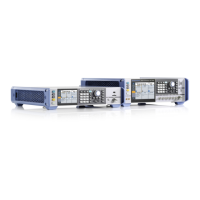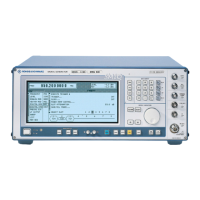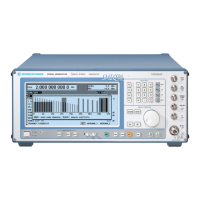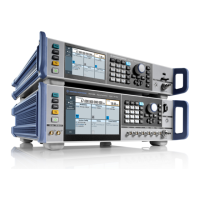Structure and Syntax of the Messages SME
1038.6002.02 3.10 E-13
Block data Block data are a transmission format which is suitable for the transmission of
large amounts of data. A command using a block data parameter has the
following structure:
Example: HEADer:HEADer #45168xxxxxxxx
ASCII character # introduces the data block. The next number indicates how
many of the following digits describe the length of the data block. In the example
the 4 following digits indicate the length to be 5168 bytes. The data bytes follow.
During the transmission of these data bytes all End or other control signs are
ignored until all bytes are transmitted. Data elements comprising more than one
byte are transmitted with the byte being the first which was specified by SCPI
command "FORMat:BORDer".
The format of the binary files within the block depends on the IEC-bus
command
The commands
:SOURce:LIST:DWELl
:SOURce:LIST:FREQuency
:SOURce:LIST:POWer
:SOURce:CORRection:CSET:DATA:FREQuency
:SOURce:CORRection:CSET:DATA:POWer
:SYSTem:MSEQuence:DWELl
:SYSTem:MSEQuence:RCL
use the IEEE-754 format for double precision floating point numbers. Each
number is represented by 8 bytes.
Example:
a# = 125.345678E6
b# = 127.876543E6
CALL IBWRT(generator%, "SOURCE:CORRECTION:CSET:DATA:FREQ
#216" + MKD$(a#) + MKD$(b#))
– '#' in the command string introduces the binary block,
– '2' indicates that 2 digits specifying the length will follow next,
– '16' is the length of the binary block (in bytes), here: 2 double precision
floating pooint number with 8 bytes each.
– The actual binary data follow now. As the function IBWRT requires a text
string, MKD$ is used for the type conversion.
The following ASCII format has the same effect:
CALL IBWRT(generator%, "SOURCE:CORRECTION:CSET:DATA:FREQ
125.345678E6, 127.876543E6")
The commands
:SOURce:DM:DATA:DATA
:SOURce:DM:DATA:ATTenuate
:SOURce:DM:DATA:BURSt
use a bit-by-bit format. The data transmitted are evaluated byte by byte from the
left to the right and from the MSBit to the LSBit.
Example:
The following sequence of modulation data is to be transmitted as a binary
block:
01010101 00110011 00001111 11111111 00000000 (binary representation)
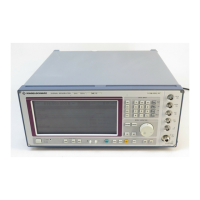
